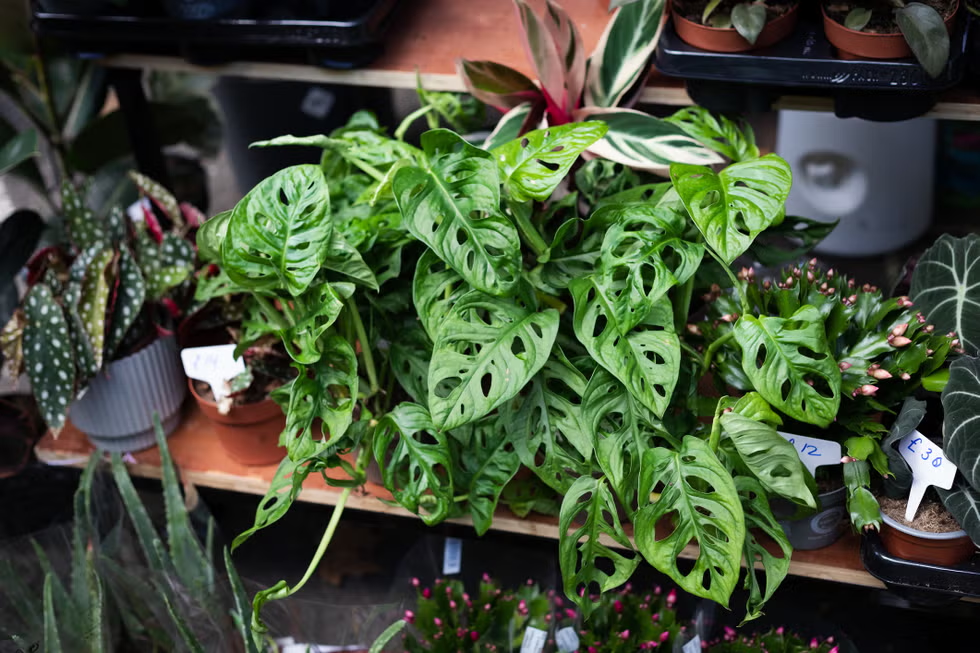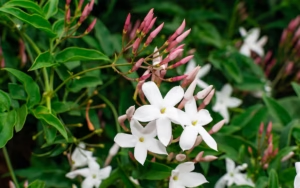Swiss cheese plants (Monstera deliciosa) are among the most popular houseplants for both beginners and seasoned plant lovers. Known for their large, hole-filled leaves and unique tropical aesthetic, these plants can instantly elevate the look of any space. If you’re ready to grow and care for a Swiss cheese plant, this guide will help you keep it healthy, happy, and thriving.
Quick Reference Table
| Common Name | Swiss Cheese Plant |
|---|---|
| Botanical Name | Monstera deliciosa |
| Family | Araceae |
| Plant Type | Perennial, Vine |
| Mature Size | 6-10 ft indoors, larger outdoors |
| Sun Exposure | Bright, indirect light |
| Soil Type | Well-draining, rich soil |
| Soil pH | Slightly acidic to neutral (5.5-7.0) |
| Hardiness Zones | 10-12 (USDA) |
| Native Area | Central America, Mexico |
| Toxicity | Toxic to pets and humans (if ingested) |
Swiss Cheese Plant Care
Caring for a Swiss cheese plant is straightforward if you meet its basic needs. It loves a tropical environment, but it’s adaptable and can thrive in most homes.
1. Light Requirements
Swiss cheese plants thrive in bright, indirect light. In their native habitats, they grow under the canopy of larger trees, receiving dappled sunlight. Mimic this environment by placing your plant near an east- or south-facing window where it gets filtered light.
- Avoid direct sunlight: Too much sun can scorch its leaves, causing brown spots.
- Low-light conditions: While it can tolerate some low light, the plant will grow more slowly, and the leaves may not develop the characteristic holes (fenestrations).
2. Watering
Overwatering is one of the most common mistakes with Swiss cheese plants. The key is to keep the soil slightly moist but not soggy.
- Water the plant when the top 2-3 inches of soil feel dry to the touch.
- Use a pot with drainage holes to prevent waterlogging.
- In winter, reduce watering as the plant’s growth slows.
Pro Tip: Stick your finger into the soil to test moisture levels before watering.
3. Humidity and Temperature
Swiss cheese plants thrive in a humid environment with temperatures ranging between 65°F to 85°F (18°C to 30°C). If your home is dry, especially during winter, increase humidity using these methods:
- Place the plant near a humidifier.
- Group plants together to create a natural humid environment.
- Use a pebble tray: Place the plant on a tray filled with water and pebbles.
Keep the plant away from cold drafts and sudden temperature changes. Avoid placing it near heaters or air conditioners.
4. Soil
Use a well-draining, rich potting mix. A mix containing peat moss, perlite, and orchid bark works well for Monstera plants. The soil should retain some moisture but not stay waterlogged.
- Soil pH: Slightly acidic to neutral (5.5-7.0).
5. Fertilizing
Feed your Swiss cheese plant during its active growing season (spring and summer).
- Use a balanced, water-soluble fertilizer once a month.
- Reduce fertilizing in fall and winter when the plant’s growth slows.

Types of Swiss Cheese Plant
There are several types of Monstera that are often referred to as Swiss cheese plants. Here are the most popular ones:
1. Monstera deliciosa
The classic Swiss cheese plant known for its large, glossy green leaves with dramatic fenestrations (holes). It is the most common variety grown indoors.
2. Monstera adansonii
This variety has smaller, thinner leaves with more delicate and numerous holes. It’s often grown as a trailing or hanging plant.
3. Monstera borsigiana
Similar to Monstera deliciosa but with a vining growth habit and slightly smaller leaves.
4. Monstera obliqua
Known for its extremely delicate, lace-like leaves. This type is rare and requires high humidity to thrive.
5. Variegated Monstera
These varieties, such as Monstera deliciosa ‘Albo Variegata,’ have stunning white or cream variegation on the leaves. They are highly sought after and more expensive.
Pruning
Pruning keeps your Swiss cheese plant healthy and encourages new growth.
When to Prune
Prune your Swiss cheese plant in spring or summer, when it’s actively growing.
How to Prune
- Use clean, sharp pruning shears.
- Remove any dead, damaged, or yellowing leaves.
- Trim back long stems to encourage a bushier appearance.
- Cut just above a node (the point where leaves or aerial roots grow) to encourage new growth.
Pruning also helps control the size of the plant, which can become quite large indoors.
Propagating Swiss Cheese Plant
Propagating your Swiss cheese plant is easy and a fun way to expand your plant collection or share with friends.
1. Stem Cuttings
The most common method of propagation is using stem cuttings.
- Step 1: Cut a healthy stem that has at least one leaf and one node.
- Step 2: Place the cutting in a jar of water, ensuring the node is submerged.
- Step 3: Place the jar in a spot with bright, indirect light.
- Step 4: Once roots grow to about 2-3 inches, plant the cutting in a pot with well-draining soil.
2. Air Layering
For larger plants, you can use air layering to propagate.
- Wrap a moist ball of sphagnum moss around a node.
- Secure the moss with plastic wrap.
- After roots develop, cut the stem below the rooted node and plant it in soil.
Potting and Repotting Swiss Cheese Plant
Swiss cheese plants grow quickly and need repotting every 1-2 years.
When to Repot
Repot in spring or summer when the plant is actively growing.
How to Repot
- Choose a pot 1-2 inches larger than the current one with drainage holes.
- Use fresh, well-draining potting mix.
- Gently remove the plant from its old pot, being careful not to damage the roots.
- Place the plant in the new pot, fill it with soil, and water thoroughly.
Common Pests & Plant Diseases
Pests
- Spider Mites: Look for webbing on the leaves.
- Mealybugs: Small, white, cotton-like insects.
- Scale: Hard, brown bumps on stems and leaves.
Solution: Use insecticidal soap, neem oil, or wipe the leaves with a damp cloth.
Diseases
- Root Rot: Caused by overwatering and poor drainage.
- Leaf Spot: Yellow or brown spots caused by fungal or bacterial infections.
Prevention: Avoid overwatering and ensure good air circulation.
Common Problems With Swiss Cheese Plant
1. Yellow Leaves
- Cause: Overwatering or poor drainage.
- Solution: Let the soil dry between waterings.
2. Brown Leaf Tips
- Cause: Low humidity or underwatering.
- Solution: Increase humidity levels and check watering habits.
3. No Fenestrations
- Cause: Insufficient light.
- Solution: Move the plant to a brighter spot with indirect light.
Swiss Cheese Plant vs. Monstera: Is There a Difference?
The term “Swiss cheese plant” usually refers to Monstera deliciosa, but sometimes it’s confused with other Monstera species like Monstera adansonii. The main differences are:
- Monstera deliciosa: Larger leaves with distinct splits and holes.
- Monstera adansonii:
FAQ
1. How fast does a Swiss cheese plant grow?
With the right care, Swiss cheese plants can grow 1-2 feet per year indoors. Their growth rate depends on factors like light, water, humidity, and soil quality.
2. Can a Swiss cheese plant grow outside?
Yes, Swiss cheese plants can thrive outdoors in USDA hardiness zones 10-12. They need partial shade and a warm, humid environment.
3. How often should I water my Swiss cheese plant?
Water the plant when the top 2-3 inches of soil are dry. This usually means watering once a week, but it can vary depending on temperature and humidity.
4. Are Swiss cheese plants toxic to pets?
Yes, Swiss cheese plants are toxic to cats, dogs, and humans if ingested. Keep them out of reach of curious pets and children.
5. Why are my Swiss cheese plant’s leaves turning yellow?
Yellow leaves are often a sign of overwatering. Ensure the soil is well-draining, and allow it to dry slightly between waterings.
6. How can I encourage fenestrations (holes) in the leaves?
To promote fenestrations:
- Provide bright, indirect light.
- Ensure the plant has enough nutrients by fertilizing regularly.
- Allow the plant to mature, as younger leaves don’t always develop holes.
Read also: https://techcrunchs.net/philodendron-how-to-grow-and-care-philodendron/








